1990s: When Romance Got Real
What if you could trace the evolution of the romance genre, one era at a time?
You’d meet heroines who didn’t need rescuing, alpha vampires with brooding souls, and a publishing industry learning to stretch—awkwardly, messily—toward something bigger.
Last week we traveled through the 1980s, when romance became a billion-dollar phenomenon powered by clinch covers, alpha heroes, and sweeping sagas.
This week, the story shifts. Because the 1990s didn’t just build on that firestorm—they changed its shape.
Missed the 80s? Catch up here:
This post contains affiliate links. That means we receive a small commission at no cost to you from any purchases you make through these links.
Romance Gets Real
If the 1980s were the golden age of larger-than-life fantasy, the 1990s were the decade romance grounded itself in emotional reality. Readers still wanted to be swept away—but they also wanted heroines who fought their own battles, heroes who healed their own wounds, and stories that didn't flinch from life's messier moments.
This was the era where love didn’t just conquer all—it had to work for it.
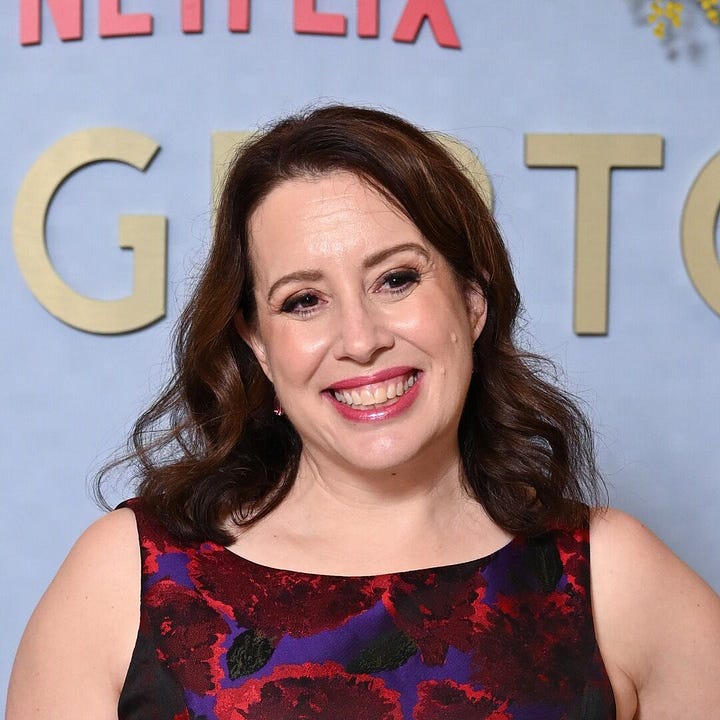
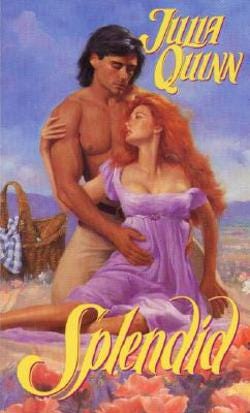
What Were Readers Reading?
Readers in the 1990s weren't letting go of historicals—but they wanted something more. They wanted heroines who were clever, resilient, and unapologetically themselves.
Authors like Julia Quinn (Splendid) and Mary Jo Putney (The Rake) moved away from the high-drama bodice ripper traditions, infusing their Regencies with humor, emotional vulnerability, and heroines who demanded—and got—respect.
Contemporary romance exploded alongside them. Nora Roberts’s sprawling family sagas (The Stanislaskis) blended romance with the rich textures of everyday life: careers, conflicts, messy families, dreams, and disappointments.
Meanwhile, paranormal romance crept onto the shelves, led by authors like Christine Feehan (Dark Prince), bringing vampires, shapeshifters, and cursed immortals into the romance spotlight.
And tucked into the mainstream? A fresh voice: Chick lit—stories like Bridget Jones’s Diary that chronicled the chaos of modern womanhood with a wink, a glass of wine, and a dash of self-deprecation.
Tropes, Character Types, and Emotional Blueprints
The 1990s kept some of the fantasy, but the emotional expectations changed.
Alpha heroes were still around—but now they were just as likely to be wounded cops, guilty billionaires, or lonely single dads as pirate lords or dukes. Emotional vulnerability wasn't just allowed—it was expected.
Tropes shifted, too:
Friends to lovers became a comfort read for a generation that wanted love rooted in trust.
Second chances and healing from trauma shaped everything from contemporary to paranormal.
Workplace romance flourished, with heroines balancing ambition and personal fulfillment.
Fated mates emerged as a staple in paranormal, giving love a mythic, inevitable weight.
Across all subgenres, the heart of the story was about earning love—not simply claiming it.
Who Was Writing Romance?
The 1990s introduced a wider range of voices—and finally began acknowledging that love stories didn’t look the same for everyone.
Authors like Beverly Jenkins (Indigo) and Sandra Kitt (The Color of Love) told stories that centered Black love, Black history, and Black communities, pushing back against a publishing landscape that had long marginalized those stories.
Jennifer Crusie (Tell Me Lies) brought humor, snark, and a fierce feminist sensibility to contemporary romance, writing heroines who weren't perfect—and didn’t have to be.
Authors like Linda Howard and Suzanne Brockmann crossed genre lines, building love stories inside thrilling, high-stakes plots where danger made every emotion sharper.
The message was growing louder: love stories could be messy, complicated, and as diverse as the readers devouring them.
Subgenres Take Center Stage
The 1990s weren’t just about more romance—they were about more kinds of romance.
Paranormal Romance: Vampires, gods, and shapeshifters surged into the mainstream, offering dark fantasy lovers immortal stakes (Dark Prince).
Romantic Suspense: Danger and desire collided in a big way. Authors like Linda Howard (Dream Man) and Sandra Brown (The Witness) ruled the bestseller lists with stories that blended survival and seduction.
Chick Lit: Bridget Jones, shoes, wine, and therapy. These heroines weren't chasing fairy tales—they were surviving (and occasionally thriving) in the chaos of modern life.
Multicultural Romance: Although slow to gain full industry support, authors like Beverly Jenkins began to carve spaces for authentic Black love stories—and readers showed up.
And while full-length historicals shifted toward wit and depth, category lines like Harlequin Presents doubled down on fantasy. Exotic tycoons, sheikhs, and billionaires swept heroines into whirlwind romances—often packaged with minimalist circle-art covers that promised big emotions inside a small, recognizable frame.
The walls were cracking—and in that messy splintering, new stories thrived.
Covers: From Clinches to Chic
The clinch wasn’t gone—but it was getting a makeover.
Historical romance covers softened, favoring pastel tones, watercolor skies, and heroines in luxurious gowns with more suggestion than scandal. Clinches remained, but the compositions became more romantic than raunchy.
Contemporary romance leaned into chic minimalism. Bold fonts. Pastel backdrops. Close-ups of intertwined hands, a single rose, or a heroine laughing alone.
And paranormal? They didn’t just hint at otherworldly love—they broadcasted it. Misty forests, stormy skies, glowing eyes, and Gothic-style fonts became visual hallmarks of the genre. Where contemporaries went pastel and historicals went lush, paranormal romances signaled their danger and intensity before readers even turned the first page.
Stepbacks reached their artistic peak in the 1990s. Publishers perfected the formula: a simple outer cover—pastel backgrounds, embossed titles, maybe a discreet icon like a flower or ring—hid a lush, full-color clinch tucked inside. It was marketing genius: readers could carry a romance book in public without blushing, but still enjoy the drama once they flipped open the cover. Illustrators became legendary for these sweeping, romantic hidden scenes. Stepbacks weren’t just a secret—they were a reward.
As illustrator Elaine Duillo later explained, stepbacks weren’t always a perfect marketing choice—especially for busy readers grabbing books on the fly:
“I did have an argument with a publisher once. He thought it was very thrilling to put an outside cover and the ‘tip-in’ using the entire cover art on an inside cover so they had the whole thing inside. Big mistake! Johanna Lindsey became big and wanted that, so publishers tried to do this with other books too. The book buyers, women with a stroller with a kid and another kid that’s going out of her sight, they have to pick up a book quickly. They are all aware of the ‘tip-in,’ but they’re not going to do that, they’re going to pick up the book with the cover image they like and that they can see immediately.”
— Elaine Duillo, Illustration Magazine #37 (Spring 2012)
Fabio: From Cover Model to Pop Icon
While Fabio debuted on romance covers in the late 1980s, the 1990s cemented his place in pop culture. He was everywhere—from butter commercials to sitcom cameos to his own line of ghostwritten romance novels (Pirate, Viking).
Fabio wasn't just selling romance novels. He became the visual shorthand for the genre in public imagination—glorious, exaggerated, and unforgettable.
In a later interview, Fabio reflected:
“Movies sell fantasy — books, even more. Because when you read the book, you really have your own fantasy, and not the fantasy of some director or producer. And so it gets even more into your consciousness. These women are very, very into the romance novel ... to the point where it's really in their psyche.”
And he wasn’t wrong. These books—and their fantasies—lodged themselves deep into readers’ emotional landscapes.
Struggling Toward Real Representation
While the 1990s made strides, the road to true diversity was slow and uneven.
Beverly Jenkins and Sandra Kitt were trailblazers, but mainstream publishing continued to center white, heteronormative love stories. Latinx, Asian, and Indigenous authors were largely absent from traditional houses—and when diverse characters appeared, they were often written through outsider lenses and full of stereotypes.
The rise of Black historical romances in the 1990s brought long-overdue visibility to Black love stories—but not without barriers. Authors like Jenkins and others were often given smaller marketing budgets, and while white historicals boasted sweeping clinch covers, Black romances were sometimes boxed into category lines or given less prominent packaging. Progress was happening—but the way books were presented still showed whose stories publishers prioritized.
Outside the mainstream, independent presses and small publishers—especially Black-owned ones—began building spaces for stories major houses overlooked. These movements planted the seeds for the massive indie romance revolution that would bloom in the 2000s.
The 1990s showed the appetite for broader stories was there. Publishing just needed to catch up.
Romance and the 1990s: Society Reflected
The genre didn’t change alone—it changed because the world around it was shifting.
"Girl power" feminism reimagined heroines not as women waiting to be chosen, but as women choosing themselves.
Crime culture exploded in news and entertainment, making romantic suspense stories feel thrilling and urgently relevant.
Early internet communities began connecting readers across distances—building early fandoms and fan-led conversations about what stories mattered.
Conversations about race, class, and inclusion were becoming harder for industries—including publishing—to ignore.
Romance mirrored these tensions, these hopes, and these contradictions. It stumbled, stretched, and, at its best, dreamed bigger.
Time Capsule Authors of the 1990s
These authors captured the spirit—and struggles—of a complicated decade:
Judith McNaught
Perfect (1993) — A story of trauma, survival, and second chances.
Nora Roberts
Taming Natasha (1990) — The start of the beloved Stanislaski family saga, blending small-town life, family bonds, and healing love stories.
Beverly Jenkins
Indigo (1996) — Black love stories rooted in historical resilience.
Lisa Kleypas
Dreaming of You (1994) — Tenderness, vulnerability, and unforgettable chemistry.
Suzanne Brockmann
Prince Joe (1996) — The start of the Tall, Dark and Dangerous series, pioneering military romantic suspense with Navy SEAL heroes.
Christine Feehan
Dark Prince (1999) — Paranormal passion at its brooding best.
Jennifer Crusie
Tell Me Lies (1998) — Sharp, funny, and fiercely feminist contemporary.
Loretta Chase
Lord of Scoundrels (1995) — A scandalous rake meets his match in a heroine who knows exactly how to fight for love—and make him beg for it.
Julia Quinn
Dancing at Midnight (1997) — Wit, heart, and wounded heroes.
Linda Howard
After the Night (1995) — A steamy, scandalous small-town romantic suspense where revenge and forbidden love collide.
🎥 Still obsessed with vintage romance? So are we.
We sat down with Cheyenne, a bookstagrammer, to chat about her love for messy 1990s heroes, old-school covers, and the unexpected emotional punch of reading vintage romance today.
👉 Check out the books mentioned here.
Legacy: The Genre Cracks Open
By the end of the 1990s, romance wasn’t one thing anymore. It was everything.
Family sagas. Vampire clans. Slayers and soccer moms. Chick lit heroines who spilled Chardonnay on their dating profiles. Suspenseful thrillers where love bloomed under fire.
The genre fractured—and got stronger because of it. More voices. More subgenres. More readers.
The fantasy got smarter. The heroines got braver. And romance—finally, fully—embraced that messy, beautiful truth:
Love is complicated.
And it’s still worth fighting for.
TL;DR: Why the 1990s Mattered
Romance grounded itself in emotional realism without losing fantasy.
Subgenres splintered—paranormal, suspense, chick lit, multicultural stories.
Representation struggles came into sharper focus—but seeds were planted.
Covers got chicer, darker, and more varied.
Society's tensions—feminism, crime culture, digital connection—showed up in the love stories readers craved.
The 1990s cracked romance open—and it never closed back up.
Coming Next:
Paranormal Boom, Fantasies, and the Digital Era (2000s)
When vampires ruled the shelves, e-books changed the game, and happily-ever-afters found whole new worlds to conquer.
👉 Want more? Subscribe to follow the series as we go decade by decade through romance history.
Let’s Chat
What was your favorite 1990s romance? Was it a broody vampire, a small-town family saga, or a suspenseful thrill ride? Or maybe you still remember the first time a book made you think, "Wow, romance can be this messy and real."
Hit reply or drop a comment—I’d love to hear what 90s book (or cover!) stuck with you.
Sharing our love for books as Under the Covers Book Blog since 2011, running the Romanceopoly yearly reading challenge since 2019 and hosting the Reading Under the Covers podcast since 2020. Launched Mysterylandia in 2025.
Sources, References & Fun Reads
This post draws from both original commentary and the amazing work of romance historians, bloggers, and genre obsessives. If you're curious to go deeper, here’s a few articles to check out:


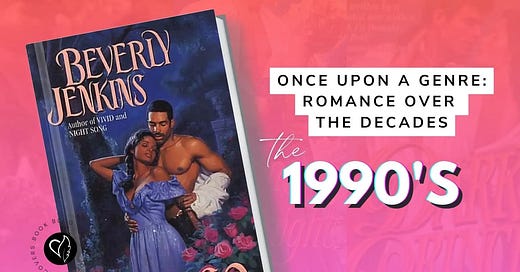



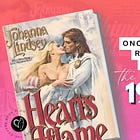
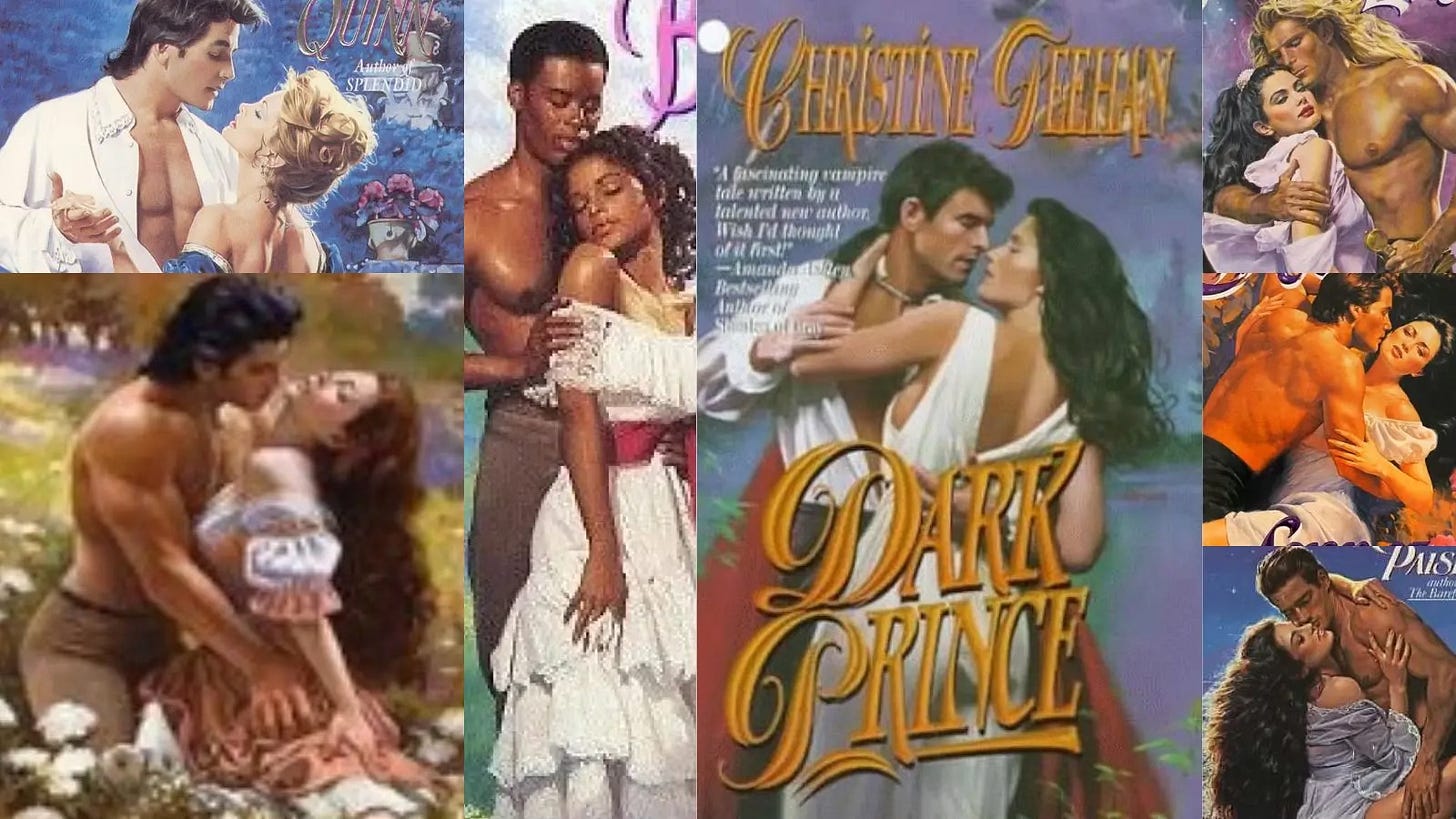


The 90's themselves were when I read so very little with a lot of other stuff going on. LOL, I've read all these authors now, but it took until twenty years later. :)
Fun seeing when they hit the big time. Yes, Bridget Jones was my first exposure to Chick Lit. Oh Fabio!
Fun post!